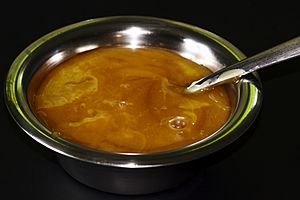Mānuka honey facts for kids
Mānuka honey is a special type of honey. It comes from the nectar of the mānuka tree. Bees collect this nectar to make the honey. The word mānuka is the Māori name for this tree. You might also see it spelled manuka without the line over the 'a'. People mostly use mānuka honey as a natural sweetener.
Contents
What is Mānuka Honey?
Mānuka honey is made by European honey bees. These bees gather nectar from the mānuka tree. The mānuka tree (Leptospermum scoparium) grows wild in Australia and New Zealand. Scientists think it first grew in Australia a very long time ago.
How Mānuka Honey Looks and Feels
Mānuka honey is very thick. This is because it has a special protein or substance in it. Its color can be from a dark cream to a dark brown. These features help you recognize it.
How Mānuka Honey is Tested
To be sold as mānuka honey from New Zealand, it must pass special tests. The Ministry for Primary Industries (MPI) in New Zealand sets these rules. The honey must pass five tests. Four tests check its chemicals. One test checks the DNA of the mānuka plant. All five tests must be passed for the honey to be called mānuka. These rules started in 2018.
Australia also has rules for its mānuka honey. The Australian Manuka Honey Association (AMHA) has its own standards. Honey with their special mark must be pure Australian mānuka honey. It must also be tested by a lab. This test checks for natural substances like methylglyoxal (MGO) and leptosperin.
Mānuka vs. Kānuka Flowers
The mānuka tree flowers at the same time as another tree called kānuka. Kānuka (Kunzea ericoides) is a similar plant. Both flowers look alike. This can make it hard for beekeepers to tell them apart. It is also hard to tell their pollen apart.
Taste of Mānuka Honey
Mānuka honey has a strong taste. People describe it as "earthy" or "herbal." It can also taste "rich and complex." The New Zealand honey industry says it smells like "damp earth" and has a "mineral, slightly bitter" flavor.
Research on Mānuka Honey
Scientists are studying a part of mānuka honey called methylglyoxal. They are looking into how it might work against certain germs. For example, they are studying it against E. coli and S. aureus. However, mānuka honey does not help prevent infections after some medical treatments.
Fake Mānuka Honey
Mānuka honey can be expensive. Because of this, some products sold as mānuka honey are not real. They might be fake or mixed with other things.
For example, a group of New Zealand mānuka honey makers found a problem. About 1,700 tons of mānuka honey are made in New Zealand each year. This is most of the world's supply. But about 10,000 tons of honey are sold as mānuka honey around the world. This includes 1,800 tons sold in the UK. This means a lot of the honey sold might not be real mānuka honey.
Tests in the UK between 2011 and 2013 showed many mānuka honeys were not real. Also, tests in Hong Kong found that some mānuka honeys were mixed with syrup. Because of these issues, the UK Food Standards Agency told sellers to make sure their honey followed the rules.
There are many different ways to rate the strength of mānuka honeys. This can be confusing for buyers. It is important to check for official certifications.



